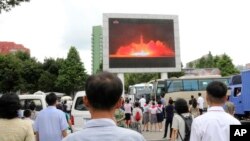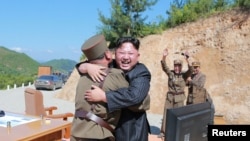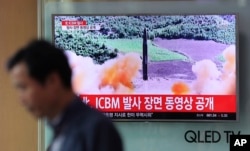North Korean leader Kim Jong-Un claimed Saturday that his country possesses missiles that could strike the entire United States mainland, following a test launch Friday.
China has condemned the launch, while Japan, South Korea and the U.S. vowed to work together on a new U.N. Security Council measure aimed at curbing North Korea’s nuclear ambitions.
North Korea has stepped up its missile testing under Kim’s reign, with the Friday launch marking its second such launch this month.
According to the official Korean Central News Agency, Kim boasted that the latest test “is meant to send a grave warning to the U.S. Kim said the test confirmed “all the U.S. mainland is within our striking range."
In response to the launch, U.S. and South Korean forces fired missiles into South Korean territorial waters Friday.
A defense official told VOA the exercise began around 5:30 pm EST.
A White House statement called the North's missile test a "reckless and dangerous action" which will further isolate the country.
The statement said "the United States will take all necessary steps to ensure the security of the American homeland and protect our allies in the region.
U.S. Secretary of State Rex Tillerson said North Korea's latest launch was "in blatant violation of multiple United Nations Security Council resolutions."
The top U.S. diplomat added, "As the principal economic enablers of North Korea's nuclear weapon and ballistic missile development program, China and Russia bear unique and special responsibility for this growing threat to regional and global stability."
Second ICBM test in July
North Korea’s intercontinental ballistic missile launch was the second in just a few weeks. The latest launch flew higher and longer than the first ICBM Pyongyang launched on July 4.
Pentagon spokesman Navy Captain Jeff Davis said North Korea launched the missile from Mupyong-ni arms plant in the country’s north.
Defense officials in Washington and Seoul, as well as private analysts, said the missile was in the air for 40 to 45 minutes, reaching a peak altitude of 3,000 kilometers and traveling some 1,000 kilometers laterally before splashing down approximately 160 kilometers west of Japan's second-largest island of Hokkaido.
Japan said the missile fell into its exclusive economic zone.
Japanese Prime Minister Shinzo Abe termed Friday’s launch a “serious and real threat” to his country's security.
After Friday’s unusual late-night launch, the top U.S. general, Chairman of the Joint Chiefs of Staff Gen. Joseph Dunford, and the head of U.S. Pacific Command, Admiral Harry Harris, called the Republic of Korea’s Joint Chiefs of Staff Chairman, General Lee Sun Jin to discuss military response options and reaffirm their “ironclad commitment” to the U.S.-Republic of Korea alliance, according to the U.S. Chairman’s office.
South Korean President Moon Jae-in said the launch by the North “clearly violates U.N. Security Council Resolution and it is a grave threat to international peace and security."
Moon added that “once again we urge North Korea to awaken from a vain illusion such as developing a nuclear program and missiles and instead choose a new path for a dialogue."
While the type of missile tested is yet unconfirmed, the preliminary data is “fully consistent with a Hwasong-14 tested with a larger second stage that is powered by a high-thrust engine,” according to Michael Elleman, senior fellow for missile defense at the International Institute for Strategic Studies.
“If flown on a flatter trajectory, this missile could reach as far as 9,000 to 10,000 km,”[easily putting Seattle or San Francisco on the US West Coast into range], according to Elleman, whose comments were published on the 38 North website of the US-Korea Institute at Johns Hopkins School of Advanced International Studies.
Word of Friday’s missile launch came as a bill approved by Congress calling for tougher sanctions on North Korea, as well as Iran and Russia, landed on the desk of President Donald Trump.













